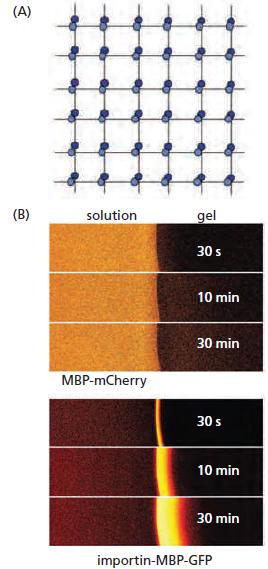The nuclear pore complex (NPC) creates a barrier to the free exchange of molecules between the nucleus
Question:
The nuclear pore complex (NPC) creates a barrier to the free exchange of molecules between the nucleus and cytosol, but in a way that remains mysterious. In yeast, for example, the central pore of the NPC has a diameter of 35 nm and is 30 nm long, which is somewhat smaller than its vertebrate counterpart. Even so, it is large enough to accommodate virtually all components of the cytosol. Yet the pore allows passive diffusion of molecules only up to about 40 kd; entry of anything larger requires help from a nuclear import receptor. Selective permeability is controlled by protein components of the NPC that have unstructured, polar tails extending into the central pore. These tails are characterized by periodic repeats of the hydrophobic amino acids phenylalanine (F) and glycine (G).
At high enough concentration (~50 mM), the FG-repeat domains of these proteins can form a gel, with a meshwork of interactions between the hydrophobic FG repeats (Figure Q12–2A). These gels allow passive diffusion of small molecules, but they prevent entry of larger proteins such as the fluorescent protein mCherry fused to maltose binding protein (MBP) (Figure Q12–2B). (The fusion to MBP makes mCherry too large to enter the nucleus by passive diffusion.) However, if the nuclear import receptor, importin, is fused to a similar protein, MBP-GFP, the importin-MBP-GFP fusion readily enters the gel (Figure Q12–2B).
Figure Q12-2

A. FG-repeats only form gels in vitro at relatively high concentration (50 mM). Is this concentration reasonable for FG repeats in the NPC core? In yeast, there are about 5000 FG-repeats in each NPC. Given the dimensions of the yeast nuclear pore (35 nm diameter and 30 nm length), calculate the concentration of FG-repeats in the cylindrical volume of the pore. Is this concentration comparable to the one used in vitro?
B. A second question is whether the diffusion of importin-MBP-GFP through the FG-repeat gel is fast enough to account for the efficient flow of materials between the nucleus and cytosol. From experiments of the type shown in Figure Q12–2B, the diffusion coefficient (D) of importin-MBP-GFP through the FG-repeat gel was determined to be about 0.1 μm2/s. The equation for diffusion is t = x2/2D, where t is time and x is distance. Calculate the time it would take importin-MBP-GFP to diffuse through a yeast nuclear pore (30 nm) if the pore consisted of a gel of FG-repeats. Does this time seem fast enough for the needs of a eukaryotic cell?
Step by Step Answer:

Molecular Biology Of The Cell
ISBN: 9780815344322
6th Edition
Authors: Bruce Alberts, Alexander D. Johnson, Julian Lewis, David Morgan, Martin Raff, Keith Roberts, Peter Walter





